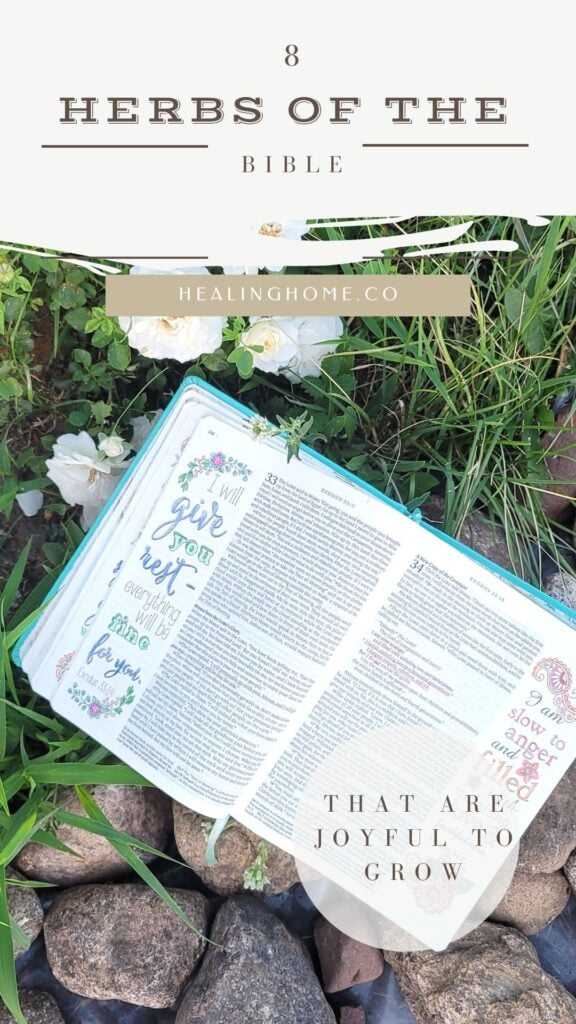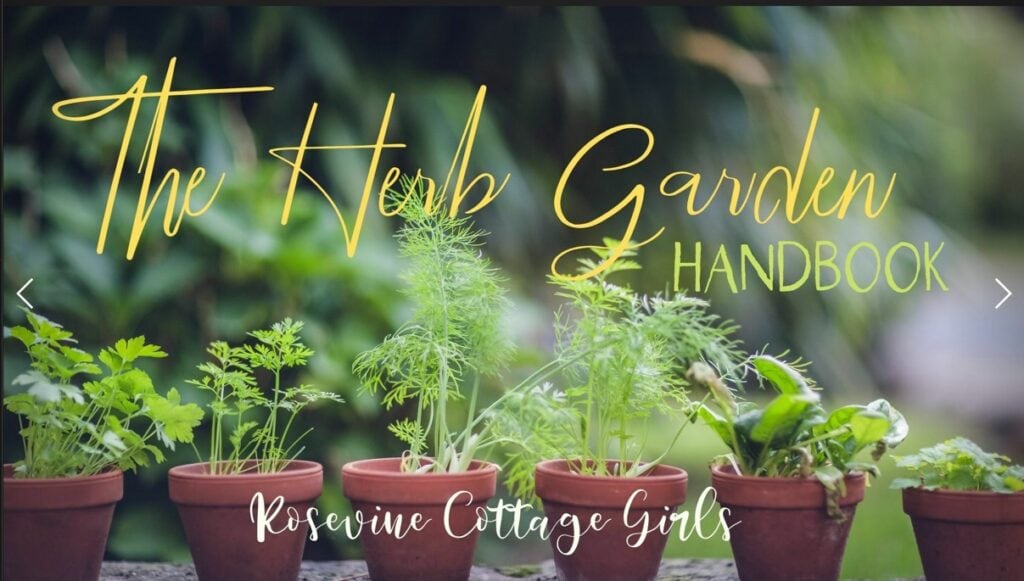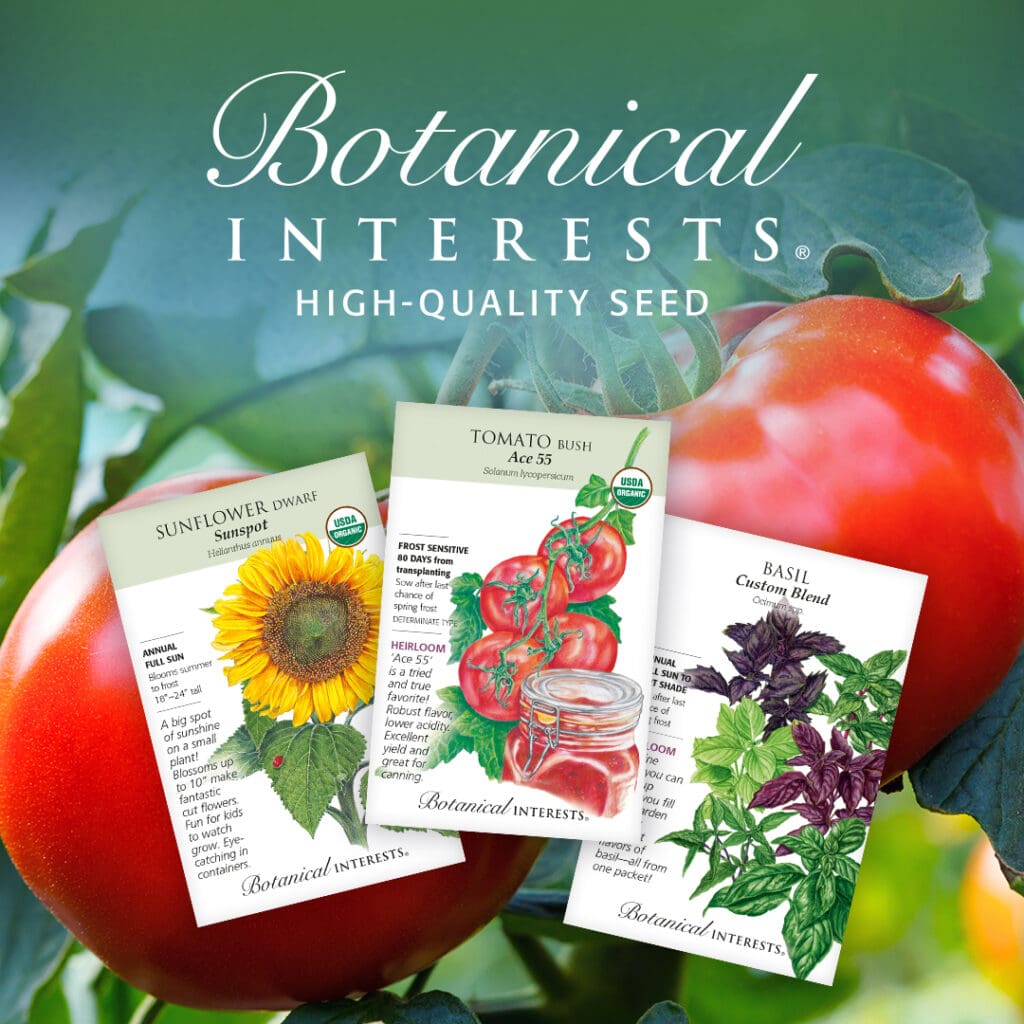Plants, botanicals, oils, and herbs of the Bible are fascinating studies. Our holy God created some magnificent plants and the Bible references many. Can we grow some of these herbs of the Bible? Absolutely! Although some are tougher to grow, there are at least 10 that you can joyfully grow in your own garden.
I love growing herbs. Right now I have two herb gardens and a myriad of other herbs planted around our property. A few years ago I started to wonder if I was growing any herbs from the Bible and was quite shocked at how many times herbs are mentioned in the Bible.
It’s important to note at this point that this is not a theological post. It will not have any spiritual applications. This article about herbs in the Bible is simply a factual post with scriptural references for the believer that is wondering what types of herbal plants were mentioned in the Bible.
There are many more than just the 10 that we are going to speak to here. After all, the ultimate author of the Bible is the creator of these herbs, so it makes sense that there are many more mentioned in the Bible.

This page may contain affiliate links. To view my full affiliate link disclosure, click here. There are Amazon affiliate links in this post. As an Amazon Associate, I make a small commission from Amazon links in this post. Find our privacy policy, terms of service, and more information about user data by visiting the links above.
Herbs of the Bible were mentioned frequently, but only ever in passing. However, there is so much imagery in the Bible about seasons, growth, plants, and nature, that it would truly be odd if we did not acknowledge that the creation that God so magnificently created was a part of the Bible.
Plants, Botanicals, and Herbs of the Bible
So what types of plants were mentioned in the Bible. By no means is this going to be an all-encompassing study. In fact, I’m sure we will only cover just a portion of a much larger study on the matter. However, here are some of the plants and botanicals that are mentioned in the Holy Scriptures.
How many herbs are in the Bible?
Although we are specifically chatting about plants of the Bible, an excellent resource on essential oils of the Bible is by Dr David Stewart. Healing Oils of the Bible will give you a deeper dive into the herbs, plants, botanicals, and oils of the Bible. Stewart claims this:
Seventy percent of the books of the Bible mention essential oils, their uses, and/or plants from which they were derived. Chapter Five of this book tabulates 1,035 such references involving 33 species of aromatic herbs and trees.
Healing Oils of the Bible
Although I am not going to mention all 33 of these species, here are some of the highlights of the plants and herbs of the Bible mentioned.
- Fig (Ficus carica)
- Hyssop (Origanum syriacum
- Mandrake (Mandragora officinarum
- Myrtle (Myrtus commnis)
- Cumin (Cuminum cyminum)
- Date Palm (Pheoenix dactylifera)
- Garlic (Allium sativa)
- Cedar (Cedrus libani)
- Aloe (Aloe Vera)
- Flax (Linum usitatissimum)
- Frankensience (Boswellia sacra)
- Milk thistle (silybum marianum)
- Myrrh (Commiphora spp.)
- Tumeric (Curcuma longa)
Why Were Plants Mentioned in the Bible?
Why mention plants and herbs of the Bible? Dr. Stewart also covers this in his book and I think his insight is fascinating.
The lack of detail of on the oils of the Bible is primarily because it was not the intent of the Bible writers to discuss oils, but to present an account of the relationship of their people with God in a historical context.
Later he goes on to write,
This leads to another point. The lack of detail int he use of essential oils of the Bible is no only because the authors were focused on otherp urposes, but also because oils, in the forms of incense, perfumes, speices, ointments, and medicines, were so much a part of the lives of everyone that no explanatinos were necessary. Why bother to explain something in print to people who already knew about common things such as oils and how to use them?
Healing Oils of the Bible
Botanical herbs, plants, and oils derived from them were mentioned in the Bible because they were a part of everyday life!
What are the 7 Holy herbs?
Although there are many more than 7 herbs mentioned in the Bible, there are around 7 that is referenced quite a bit in modern contexts. Some say there are 7 holy herbs, some say 12. Although I understand the spirit of calling these plants ‘holy’, I think there is a mistake in saying so. Each plant mentioned in the Bible is holy because it was crafted by an omnipotent and completely Holy God.
Here are seven of the herbs that are often referenced as ‘Holy Herbs.’
- Aloe – John 19:39-40.
- Flax (Linum usitatissimum) —Leviticus 6:10.
- Frankincense (Boswellia sacra) or (B. carteri)
- Garlic (Allium sativum) —Numbers 11:5-6.
- Milk thistle (Silybum marianum) —Genesis 3:18.
- Myrrh (Commiphora spp.) —Esther 2:12.
- Turmeric (Curcuma longa) —Song of Solomon 4:14-15.
10 Herbs of the Bible that Are Easy to Grow
Are there easy herbs from the Bible that are easy to grow? Absolutely, and I truly believe that they can be joyful to grow and know that you are growing such an ancient plant that was even mentioned in the Holy Scriptures.
Have you ever grown an herb garden? Experienced and novice garden growers can enjoy and benefit from my friend at Rosevine Cottage Girls’ handbook on how to grow common culinary herbs and easy recipes for bringing them into your kitchen.

Cumin
If you choose to grow cumin, you will need to research your zone hardiness fairly extensively as cumin needs at least four months of warm weather to grow well.
Dill
Dill is only referenced 3 times in the Bible, but it truly has some fascinating historical roots. Dill oil was rubbed on the bodies of gladiators before entering the arena. Why you may ask? Because it was known to reduce anxiety and nervousness.
Mint
Mint is such a joyful herb to grow. It is fresh and pure! However, the mint that was mentioned in the Bible was probably not the peppermint or spearmint that we know today. Instead, it was more likely horsemint, which is grown in the Holy Land.
Horsemint was a bitter herb that was eaten with lamb during Passover meal (Exodus 12:8; Numbers 9:11).
Regardless of the type of mint you grow, it usually is a fairly easy herb to grow and maintain. It’s easy to dry, store, and have mint tea all year round! It can even be easy to propagate it when you want more, instead of buying a brand new plant.
Anise
You may have never heard of anise, but it is a very easy herb to grow. The first time I grew it, I loved how it sprouted and smelled, but I ended up letting it go to waste because I didn’t know what to use it for!
Anise was very prized in Biblical times and it was even used as an offering because of its value. The only time it is mentioned is in Matthew 23:23, but since the plant is closely related to dill, it is speculated that the passage could be referring to dill instead. The plant is closely related to Dill so some scholars believe it was dill, not anise that was referenced.
Mustard Seed
Mustard is mentioned in the Bible typically as an oil. It was potent and usually had to be diluted with some sort of vegetable oil. The most well-known passage about the mustard seed is Matthew 13, Mark 4, and Luke 13.
Mustard seed will grow in most soil conditions, but it will flourish in well-drained soil with a pH of no less than 6.0
Bay Leaf
The bay leaf is another herbal plant that is only mentioned once in the entirety of the Bible. The passage is Psalm 37:35. Branches of bay leaves were commonly used to form crowns for rulers and military leaders during the Roman Empire.
Bay leaves are again an easy herb to grow, but it is a slow-growing plant.
Rock Rose
The Rose of Sharon is mentioned in the Song of Solomon in verse 2:1. However, it is not a typical rose that we would think of. Instead, it is most likely the rock rose or ladanum. Amazingly that type of plant is simple to grow and has healing properties that were noticed centuries ago by shepherds when they realized that their sheep would brush up against the plant and cuts would heal faster.
Typically the rock rose is used in flower gardens, and truthfully that is how I grow it as well. It’s a beautiful flower that is easy to grow.
Chamomile
This debatably should not appear on this list. The possible reference to chamomile in Psalm 103:2-3 is only speculation. The plant is so beautiful and wonderful to grow, that I had to include it on my list.
It perhaps is my favorite herb to grow because it is simple to put in body care products and consume by drying and making into teas. Not to mention that it has quick germination and is simple to grow and flourish in many soil conditions.
Why Grow Herbs of the Bible?
So you may ask, why should I grow herbs of the Bible? Truthfully the answer can be as simple as, it’s fun! I find it abundantly fun to think about the fact that these plants have been grown for medicinal purposes for years!
Where is the best place to buy seeds? I have two favorite places to buy seeds. Baker Creek is where I get a lot of my seeds and they are all heritage seeds, which gives me confidence in their seeds. However, the other seed company that I am constantly going back to because of their phenomenal prices and beautiful products is Botanical Interests. Both companies are remarkable.
Enjoy growing these wonderful and beautiful herbs of the Bible!

